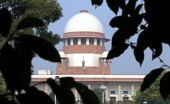Vepa Partha Sarathi (1915 – 2012): India’s last Renaissance Man.
Written by Alok // January 25, 2012 // Law & The Judiciary // 9 Comments
Contrary to what Justice Katju or anyone else might tell you, the events at Jaipur over the last week are a national disgrace.
They show that freedom of speech, even with reasonable restrictions, is at the sufferance of of the intolerant with no qualms of violence. They show that individual freedoms, far from being a Constitutional right, are treated as a function of State interest, or more precisely, the interests of the party in power. They show us that the commitment to freedom of speech and thought among our “liberal” elite is marked with pusillanimity and cowardice in the face of intimidation and threats. (Suhas’ post here says all of this, better).
One doesn’t like to speculate so freely, even on a forum as open as thus, but perhaps Prof. Dr. Vepa Partha Sarathi’s sad demise yesterday (25.01.2012) at the age of 96 is probably not unrelated to all of the above. If anything could break his strong heart (strengthened as it was by “the slings and arrows of fate”), this was possibly it. As a firm believer in the rule of law, a committed atheist, a lover of the arts (an artist himself), a man who loved his country and its founding ideals, he must have dearly felt the pain of watching his country succumb (once again) to the forces of obscurantism and intolerance. It perhaps hurt him just as bad to see 40,000 of India’s youth gathered at Jaipur, who probably shared most of his ideals, stand by and let it happen.
The biographical details of his life, while perhaps covering the major achievements in his career as a lawyer and academic do not, and possibly cannot, focus on the man himself. To us, his students at NALSAR, he will always be our “Vepa-sir” — easy going, a little hard of hearing perhaps, mentally sharp as a razor’s edge honed to the width of a molecule, with a memory that astounded us on a daily basis, and always full of good cheer and warmth. A firm believer in the uselessness of all testing and examination in the life of a student, it was impossible to dislike the man.
Yet, admirable as these qualities, these do not define him entirely.
Vepa-sir was a true polymath. Few scholars can claim to have authored a book on Ancient Indian Mathematics and Astronomy and a classic on the law of evidence, the transfer of property and the interpretation of statutes. Fewer still perhaps can claim felicity with the paint-brush or the ability to quote Gilbert & Sullivan operettas just as easily as Shakespeare; declaim from the King James Bible as easily as recite profoundly dirty limericks.
Yet, in the hands and minds of mere mortals being a polymath is a parlour trick — the ability to devote time to many different pursuits without attaining proficiency in any particular one (or as you say, “Jack of all trades, master of none”). Vepa went beyond being a mere polymath and could genuinely be called a true “Renaissance Man” – someone who respected individual freedoms, supported the pursuit of truth unburdened by religious dogma, and always brought a scientific and rational approach to the problems of humanity. As an atheist (or perhaps the more appropriate word is “rational unbeliever” for his atheism wasn’t tied merely to the traditions of Judeo-Christian & Islamic theology as the atheism of Dawkins’ and his fellow “neo-atheists’” is) he didn’t pour contempt and scorn for religions or the religious. He acknowledged the instrumental role of religion in the development and growth of civilization and was of the view that with the development of the scientific method, humanity had no need of calming superstitions that religions offered. His rationalist atheism was always worn lightly; never aggressively thrust in the face of a believer in an attempt to belittle or draw ridicule, but always propounded with a view to debate, urge, and enlighten his listeners.
I won’t say I agreed with him entirely. My own views on religion, deity and belief are perhaps more appropriate for another piece elsewhere, but suffice it to say that Vepa-sir was the epitome of the finest Indian traditions of debate and discussion that litter history and scripture, and to that extent, he taught me far more than he probably imagined he did.
Not least of all, he provided us with a role-model for a good (if not great) lawyer.
A good lawyer, according to Vepa-sir was not one who had just mastered the concepts of law, its practice and procedure, and its intricate jargon. All of those are of course necessary but definitely not sufficient to produce a good lawyer. A good lawyer had to be someone with more than a passing familiarity of literature, who appreciated the arts, who engaged freely in thoughtful debates, and engaged with the great public questions of the day. A lawyer was not just anyone with an opinion, but someone whose opinions are informed by facts, by an understanding of the issues, and by a willingness to listen to and appreciate the merits of another’s point of view. These, and these alone, stand out as the hallmark of a good lawyer.
To appreciate his idea of what it takes to be a good lawyer (or for that matter a good legal academic) read his best works; the Interpretation of Statutes and the Law of Evidence.
The first thing you’ll notice of course is the simple language. Simplicity and brevity far from being an absence of, is in fact evidence of, great understanding and wisdom. The most complex arguments on the Basic Structure Doctrine, Section 27 of the Evidence Act or the Golden Rule of Interpretation are presented with an unmistakeable clarity of thought.
Far too many of us in the daily drudgery of legal forms and practice fall prey to the sin of verbosity and prolixity (yes, irony fully intended). Monstrous, twisting clauses in contract and statute may look impressive and forbidding but make for poor application and enforcement of the law. So too are dense, indecipherable pleadings that one routinely comes across in court. Of course, simplicity is not simple, but that only heightens Vepa’s depth of learning and clarity of thought.
Reading his works one is also struck by the numerous and apt quotations on law and literature that fill his books. The intent is not so much to impress as to inform. Law, like literature, reflects and shapes society and individuals who come under its influence. Mere knowledge of law with no appreciation for literature makes for a lawyer ill equipped to understand the law itself and its purpose and role in society. In this respect, he follows the fine example of such luminaries as Chagla, Hidayatullah, Palkhivala and Krishna Iyer. His quotations range from the classic to the crass.
His books also unfailingly put forth his point of view; right or wrong. Whether it is on the correctness of the Basic Structure doctrine or the interpretation of Section 27, he makes it clear that he is no textbook writer churning out repeated editions of stale commentary for crammers and regurgitaters.
Unlike many academics in the field, he never shied away from a stiff debate with even the most ill-informed and barely articulate of his students. It didn’t matter that he had 70 years of experience at the Bar and you had none. Your views were received with just as much respect as perhaps the views of the Chief Justice of India’s did; never did he meet anyone with haughty dismissal or outright rejection by reference to his authority.
Most importantly perhaps from him I learnt that a good lawyer is also, inevitably, a good human being. Someone whose professional values sync entirely with his personal values; whose belief in the values of our Constitution isn’t worn merely within the premises of a court, or for the purposes of one’s own ends, but is the very basis of one’s life. In that perhaps, he left us a hard challenge, one that I fear I may not always be able to meet successfully. Or perhaps, the effort to meet the challenge is itself part of living a good life.
Vepa-sir lived by the one golden rule that he preached to us all, and which atheist or religious, we can all agree is essential to the functioning of any civilized society.
No, it is not the golden rule of statutory interpretation and has only vaguely to do with the law, but it goes:
“Do unto others as you’d have them do unto you“
Rest In Peace Vepa sir. Though you didn’t believe in a heaven, I do hope that you’re pleasantly surprised.





9 Comments on "Vepa Partha Sarathi (1915 – 2012): India’s last Renaissance Man."
A very well written article. He was truly a Renaissance Man, wasn’t he? I never really thought to use that phrase to describe him, but after reading your article, it seems like the best fit.
Hi Alok,
You have done a great job with this. While I was going through the flurry of facebook posts which have been put up post the demise of Vepa Sir, clearly, this article of yours covering his personality and wisdom stands out. Nicely done.
Roshan Santhalia
Thanks Sowmya and Roshan.
His passion remains unparalleled. And yes, I agree – it all stems from the simplicity of his being and doing. Very rarely do you find people doing things in life for the sake of doing them and nothing else. Truly inspiring.
Very rarely do you find people doing things in life for the sake of doing them and nothing else. Truly inspiring.
Enjoyed reading this. You have summed him up well: A rarest of rare case-An honourable man with a wicked sense of humour. He will be missed.
I never knew him, but I’ve always been a great fan of his books.
Brilliant piece, this is.
well written indeed… also Vepa Sir lived by the Gita, always duty-conscious and without expecting any reward.
Very good article Alok. I thank you and appreciate you for your affection for this great teacher.
However with all the adorable minions and unique world you
are going to forget about the similarity. There are three nights
of fun-filled Mardi Gras partying left in 2013, each one of these featuring a concert with
a nationally recognized artist. On Saturday nights from June 1 to
July 6, park guests can rock out to a live performance by way of a multi-platinum
artist with the Music Plaza, a venue illuminated from the colorful LED lights of Universal Studios’ most rockin’ coaster, Hollywood Rip Ride Rockit.
When customizing your avatar, you’ll be capable to choose the clothing and coiffure you
desire it to have. 7″ thick, and features a quad-core processor, 2GB of RAM and an Adreno 320 graphics engine. The control is easy, you have to swipe all over the place to steer clear of the obstacle, you also have to follow special instruction for certain condition around the level. In the television categories, Favorite TV Show attended Sam & Cat; Favorite Reality Show to Wipeout; Favorite Cartoon to Sponge – Bob Square – Pants; Favorite TV Actor to Ross Lynch and Favorite TV Actress to Ariana Grande.
my web site … Despicable Me Minion Rush hack 2014